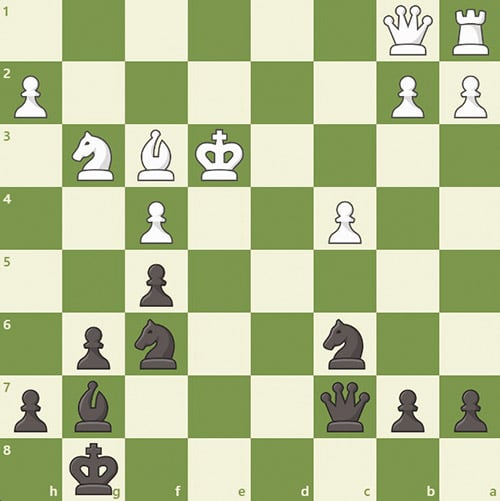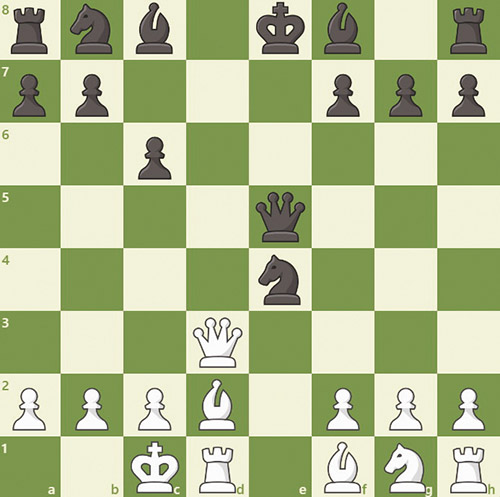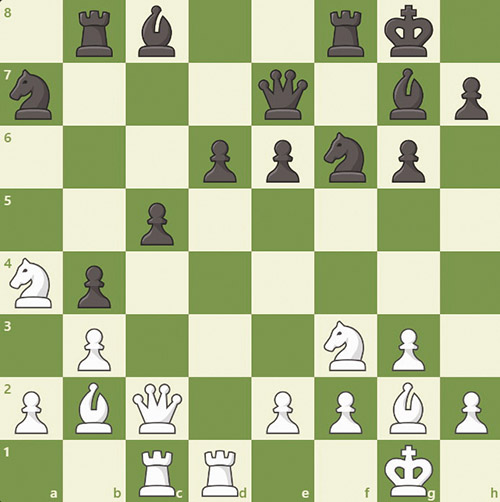
In Chess, attraction is the idea of attracting an opponent’s piece to a square where it can be further attacked or tactically exploited, often by way of a sacrifice. This concept is demonstrated in the position displayed in Figure 1 from a game between American chess legend Grandmaster Bobby Fischer with the black pieces and International Master Rene Letelier Martner with white. White is up a rook for a knight but black’s pieces are far more active and the white king is poorly defended in the center of the board. While a few other moves, such as queen to b6 and pawn h5, are still winning for black, the strongest winning move is the attraction sacrifice queen takes f4, attracting the king to the f4 square. If the king captures the queen on f4 then black checkmates white with the move bishop to h6. If the king runs to d3, e2 or f2, checkmate or the major loss of material is unstoppable for white.
Figure 2 is a position from a game between Edgard Lasker with white and George Alan Thomas with black that features a brilliant attraction sacrifice that leads to an incredible checkmate. Lasker began with 1. e4 fxe4 2. Nxe4, striking at and taking control of the center. Thomas then played 2… b6, preparing to fianchetto the bishop to the b7 square, and white continued to pressure in the center with 3. Ne5. 3…0-0 4. Bd3 Bb7 and the players continued to develop their pieces normally until white played 5. Qh5. The idea of the move is to launch an attack against the black king by bringing the queen to join the two knights and bishop in pressuring the kingside, particularly the weakened light squares around black’s castled king. Black played 5… Qe7, developing the queen so that it can help defend against a possible attack, but blundering an incredible 7 move checkmating sequence that Lasker spotted. White first sacrifices the queen with 6. Qxh7 Kxh7, attracting the black king from the backrank and preparing to bring it further into white’s territory. 7. Nxf6+ is a double check from the knight on f6 and bishop on d3 so the move 7… Kh6 is forced; if the black king retreats to h8, Ng6# is checkmate. White continues the checkmating sequence with 8. Neg4+, the only winning move in the position, 8…Kg5 9. h4+ Kf4 and Lasker continues to attract the black king into his position. 10. g3+ Kf3 and white continued to bring the black king forwards with 11. Be2+. 11… Kg2 12. Rh2+ Kg1 13. Kd2#, opening a discovered check from the rook on a1 and the black king is checkmated on the opposite side of the board!

The position shown in Figure 3 is from a game between Grandmasters Richard Reti with white and Savielly Tartakower with black from 1910. Although Tartakower is up a knight, white wins with queen to d8 check, sacrificing the queen for a forced checkmating sequence that utilizes the attraction motif. Queen to d8 forces the black king to capture and draws it out into the d file, rendering it susceptible to a discovered check from white’s d1 rook. White takes advantage of this with the move bishop to g5, double checking the black king from the d1 rook and the bishop so the king has to move. If the king goes to e8 then rook d8 is checkmate, and if it goes to c7, bishop d8 is checkmate.
Figure 4 is from a game between Grandmasters Levon Aronian with white and Hikaru Nakamura with black from the 2010 World Blitz Championship. Here, material is equal but white’s pieces are far more active and their superior placement allows for the winning attraction sacrifice: Rook takes d6. The point of the move is to capture black’s central d pawn which plays a significant role in holding the position together. Queen takes d6, capturing the seemingly free rook, attracts the queen to the same diagonal as the b8 rook and allows bishop to e5, skewering the queen and rook. This forces the queen to move off of the diagonal and, no matter where it goes, the b8 rook is left hanging and the bishop can capture it, winning back the sacrificed rook.
Ethan Feder is a junior at Yeshivat Frisch, a chess enthusiast and player. The goal of his column is to teach and discuss chess concepts through example positions, high-level games and relevant puzzles, along with explanations. Feel free to contact him with any questions, suggestions or comments at ethan.feder@gmail.com.













